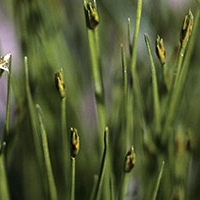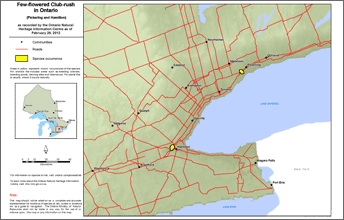Few-flowered club-rush
Scientific name: Trichophorum planifolium

Cover photo credit: Bill Crins
Status
Endangered
“Endangered” means the species lives in the wild in Ontario but is facing imminent extinction or extirpation.
Date added to the Species at Risk in Ontario List
The Few-flowered Club-rush was already assessed as Endangered when the Endangered Species Act took effect in 2008.
What it looks like
The Few-flowered Club-rush is a woodland sedge. Sedges are similar to grasses, but with a few key differences. Sedges typically have triangular, solid stems. Grasses have hollow, round stems.
The Few-flowered Club-rush flowers early in the spring before the trees grow their new leaves. The flowers are not showy and the stamens and stigmas dangle outside the flower where they are pollinated by the wind.
Where it lives
This species is usually found on steep slopes of oak forests.
Where it’s been found in Ontario
In Ontario, it grows at just two sites, at the Royal Botanical Gardens near Hamilton and Rouge Park in Toronto.
The species is found in the eastern United States and is relatively common in the Appalachians and the Atlantic coastal plain.
It ranges from Virginia and Missouri north to New York, Pennsylvania and Ohio.
View a Larger version of this map (PDF)
What threatens it
Little is known about the historic distribution and abundance of this sedge in Ontario. It was only recently discovered in Ontario (1955). Soil erosion may be a threat.
Other threats may include trampling, browsing by deer, and competition from invasive non-native plants.
Action we are taking
Endangered Species and their habitat are automatically protected
Recovery strategy
A recovery strategy advises the ministry on ways to ensure healthy numbers of the species return to Ontario.
Read the executive summary (February 18, 2010)
Read the recovery strategy (February 18, 2010)
Government response statement
A government response statement outlines the actions the government intends to take or support to help recover the species.
Read the government response statement (November 18, 2010)
Five-Year Review of Progress
A five-year review reports on progress made toward protecting and recovering a species, within five years of publishing a species’ government response statement.
Read the report on progress towards the protection and recovery of 13 species at risk, including Few-flowered Club-rush (2015)
Habitat protection
A habitat regulation defines a species' habitat and many describe features (e.g., a creek, cliff, or beach), geographic boundaries or other unique characteristics.
Read the regulation (February 18, 2010)
What you can do
Report a sighting
- Report a sighting of an endangered animal or plant to the Natural Heritage Information Centre. Photographs with specific locations or mapping coordinates are always helpful.
Volunteer
- Volunteer with your local nature club or provincial park to participate in surveys or stewardship work focused on species at risk.
Be a good steward
- Private land owners have a very important role to play in species recovery. If you find Few-flowered club-rush on your land, you may be eligible for stewardship programs that support the protection and recovery of species at risk and their habitats.
- Invasive non-native plants pose a threat to the native Few-flowered Club-rush. If you live near a natural area avoid planting invasive plants such as bush honeysuckles, barberry, asiatic bittersweet, autumn olive, English ivy, goutweed, snow-on-the- mountain, and day lilies. Ask your garden centre or native plants nursery for the best native plants for your home and ponds.
Report illegal activity
- Report any illegal activity related to plants and wildlife to
1-877-TIP-SMNR (847-7667) .
Quick facts
- All Canadian populations of the Few- flowered Club-rush have been found near openings in the forest canopy. This suggests that once the ground is heavily shaded, this sedge cannot survive at that location.
